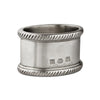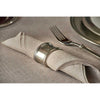Luisa Oval Napkin Ring (Set of 2) - 5.5 cm x 4.5 cm - Handcrafted in Italy - Pewter
Handcrafted by Italian pewterers, this solid pewter Luisa oval napkin ring has the elegance required of a formal table setting, yet at the same time the simplicity necessary for everyday use. It is 'cousin' to Cosi Tabellini's Luisa round napkin ring.
Buying as a gift? Why not make it even more special with our engraving service?
Napkin rings are an invention of the European bourgeoisie, first appearing in France about 1800 and soon spreading to all countries in the western world and were originally used to identify the napkins of a household between weekly wash days.
Napkin rings appear as single items with the name or initials of the owner, notably given as christening presents, or pairs often given as gifts at weddings and silver weddings.
Using a napkin elevates a meal to something a little bit special, and the reassuringly solid Cosi Tabellini napkin ring adds to a special occasion without bringing pomposity to the table.
NAPKIN HISTORY
The first napkin was a small lump of rolled out dough used by Spartans called 'apomagdalie'; a custom that led to using sliced bread to wipe the hands. In Roman times, napkins, known as sudaria (from the Latin for "handkerchief"), were pocket-sized pieces of cloth to mop ones brow during meals taken in the warm Mediterranean climate, and mappae were larger pieces of cloth spread over the edge of the couch whilst eating food in a reclining position, 'Peel me another grape, slave!'. Both 'napkins' were also used to blot the lips. Each guest would bring his or her own, and any food left over was distributed into them; an early version of today's 'doggy-bag'.
Bread, clothing, back of hands - whatever was around really - were used in the Dark & Middle Ages, then the napkin returned, but as a communal one, about the size of a bath towel, and later called a touaille, and hung on a piece of wood, passed around the table, unless you were of high status, who seem to have used some form of napkin throughout the ages.
The carrying of the napkin was all part of the dining ritual. The Bayeux tapestry depicts a servant kneeling before the high table with a finger bowl and napkin - there were a number of napkins used during a formal meal, including one carried by the cup-bearer, who would traditionally kiss the napkin on which the lord wiped his hands upon and then drape it over the lord's left shoulder.
For the host and high status guests, napkins were carried around by the waiting staff, over the shoulder of the maître d', over the arm of the servants, always on the left - which continued into the 18th Century. In fact the napkin is still placed to the left in the US, whilst in Europe it is most often to the right of a place setting. "If napkins are distributed, yours should be placed on the left shoulder or arm; goblet and knife go to the right, bread to the left." Erasmus, De Civilitate Morum Puerilium, 1530.
By the seventeenth century, the standard napkin was large; approximately 90 x 115 cm, because people still ate with their fingers, although there were certain rules of etiquette, for example A French treatise dating from 1729 stated how and when to use the napkin - "It is ungentlemanly to use a napkin for wiping the face or scraping the teeth, and a most vulgar error to wipe one's nose with it." and "The person of highest rank in the company should unfold his napkin first, all others waiting till he has done so before they unfold theirs. When all of those present are social equals, all unfold together, with no ceremony."
As the fork began to be used by royalty and others within the aristocracy, and later, by the 18th Century, by all, the large napkins fell out of fashion, as tidy dining became the norm. Napkins became smaller, however napkins were still used in a way that is not usual today. For example; it was fashion for men at that time to wear starched ruffled collars, which encouraged the trend of tying a napkin around ones neck to protect the collar, resulting in the expression "to make ends meet.". So the napkin, or serviette, or diaper in English, has been part of the evolution of society for several millenia.
Sold in pairs.
Size: 5.5 cm x 4.5 cm
Materials Used: Pewter
Ref: CT0383701
Designer: Giorgio Tabellini.
100% Lead Free
All Cosi Tabellini Pewter is 100% lead-free, so it is totally food & drink safe, and is both EU and US FDA approved.
Packaging
Cosi Tabellini pieces come gift-boxed with a guarantee card and instructions on how to care for pewter.



